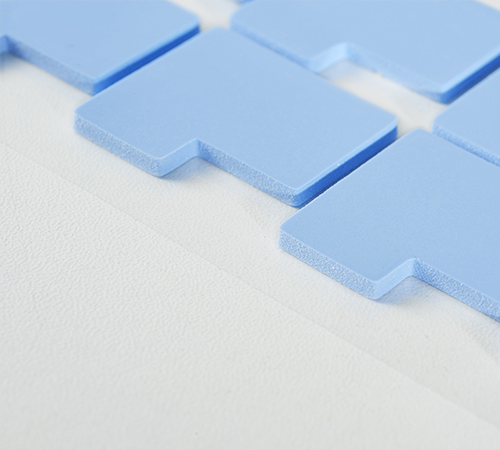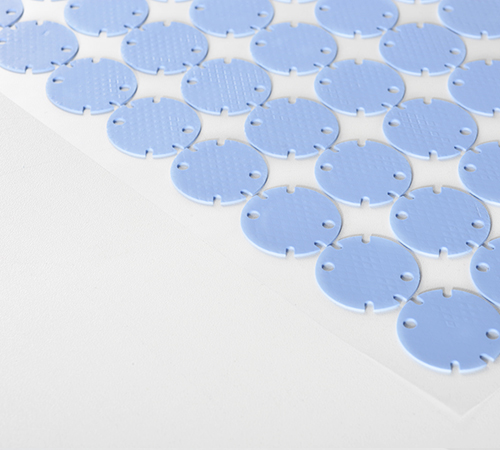How long is the service life of silicone thermal pads ?
Author:Nfion Thermal Pads Manufacturer
Date:2024-04-29 09:51:06

Thermally conductive silicone pads, as a highly efficient thermal management material, are widely employed in electronic devices, such as CPU cooling, LED lighting, power supplies, and various high-power electronic components. Their primary function lies in filling the gaps between electronic components and heat sinks, thereby reducing contact thermal resistance and enhancing heat transfer efficiency to ensure the long-term stable operation of equipment.
The lifespan of thermally conductive silicone pads is intertwined with numerous factors, including material composition, manufacturing processes, usage environments, and application methods. As a thermal material manufacture , Nfion Thermal will provide a detailed explanation from a professional standpoint and offer advice on extending the lifespan of these silicone pads.
Firstly, the longevity of thermally conductive silicone pads typically hinges on the stability of their materials and adaptability to environmental conditions. Premium silicone pads should exhibit exceptional thermal, chemical, and mechanical stability, maintaining consistent thermal conductivity over a wide temperature range. They should also provide buffering, damping, and noise reduction capabilities to cope with diverse operational environments. Under normal usage conditions, the lifespan of these pads generally ranges from 5 - 10 years or more.
However, this lifespan is not immutable; it is influenced by several variables. Environmental factors such as temperature, humidity, and exposure to chemicals can all impact the performance of thermally conductive silicone pads. High temperatures, high humidity, or chemically corrosive environments can degrade the performance and shorten the lifespan. Moreover, incorrect usage methods, like excessive bending, stretching, or compression during installation, or exposure to substantial external forces during operation, can lead to premature failure.
To prolong the lifespan of thermally conductive silicone pads, users should adhere to proper usage practices. When installing, care must be taken to avoid over-bending, stretching, or compressing the pads to prevent internal structural damage. Regular cleaning of the pad's surface to remove dust and dirt is also crucial for maintaining optimal thermal conductivity. Furthermore, minimizing prolonged exposure to extreme temperatures, humidity, or corrosive environments is essential to prevent detrimental effects on performance.
In addition to correct usage, selecting high-quality thermally conductive silicone pads is vital for extended lifespan. Users should consider the following when making a selection:
- Material and Manufacturing Process: Top-quality pads are made from high-grade raw materials using advanced processes, ensuring excellent thermal performance and stability. Consider the manufacturer's reputation and capability alongside product specifications.
- Thermal Conductivity Coefficient: This is a key indicator of a thermal material's performance. Higher coefficients denote better conductivity, but other factors such as thickness, hardness, and density should also be considered based on the specific application.
- Temperature Resistance Range: The operational temperature range is another critical factor in selection. Choose a pad suitable for your equipment's working environment and conditions to guarantee stable thermal conductivity across varying temperatures.
- Environmental Friendliness: Opt for products that meet environmental standards, free of harmful substances, and environmentally friendly.
Users can also reference quality inspection reports and customer reviews to evaluate product performance and quality. Selecting reputable brands and reliable suppliers enhances the likelihood of quality products and post-sales support.
In summary, the lifespan of thermally conductive silicone pads is influenced by multiple factors, with appropriate usage and suitable product selection being pivotal to longevity. As a manufacturing engineer, I recommend adhering to correct operational procedures and opting for high-quality, performance-stable products. Pay attention to environmental compatibility and product specifications like eco-friendliness and temperature resistance. Beyond these, storage conditions and transportation methods can also affect the pads; hence, protecting them from damage or contamination is crucial.
With technological advancements and innovations in thermal material development, future prospects may include even more high-performance, long-lasting thermally conductive silicone pad options. Users should stay informed and select products according to their needs and market developments.
Lastly, it's important to note that the lifespan of thermally conductive silicone pads is a multifaceted issue. Besides product quality and performance, users should prioritize correct usage and maintenance practices to maximize lifespan, ensuring the stability and reliability of the equipment they support.
 CN >
CN >



